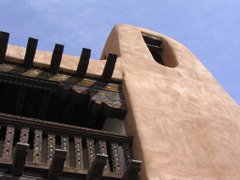Have not called to ask if this is also available for homeschool teachers but if you are interested give her a call, in the past they have been willing to invite homeschoolers to their trainings and workshops and this one looks like fun!--Tabbi
Want to participate in real ecology research at the Sandia Mountain Natural History Center next year?
This project can be used to meet Life Science and Scientific Thinking and Practice standards for any grade level. The close observation and analysis involved in this type of long-term study can really help students form a meaningful connection to the land. The procedures are simple enough to be done with elementary students, yet the data can be analyzed at any level from elementary to high school. Your students will be doing real, hands-on, place-based science, and having fun at the same time!
We will be studying two 50x100 ft sites on our property in Cedar Crest. One is located in a grassy meadow; the other is located in what is now a dense pinon-juniper forest. The forest site will be thinned to reduce fire danger this summer, so we also want to see how the area changes as it recovers from the thinning. Our basic research questions are: What populations of plants, insects and small mammals do we have at different times of year? What are the differences between our meadow and piñon-juniper ecosystems? How will the piñon-juniper forest change as it recovers from thinning? We will be setting live traps for small mammals and pitfall traps for arthropods, taking inventory of plants on transects, as well as keeping a record of weather data that may correlate to these populations. We would like to have groups come out a few times over the course of the school year to collect data and observe what's going on in the ecosystem. How many times and what you study is up to you; just contact us to set up a program that works for you.
There are several different ways to approach this project. Your group could focus on plants or arthropods and compare data from the two different sites. Or you could look at both plants and arthropods to see how they relate to each other in just one of the sites. Or... come up with your own question! The rich data set we will collect can be used to answer many different questions. Possible topics include: soil health, native vs. invasive plants (such as cheatgrass, toadflax, sweet clover), or how the weather influences what wildflowers we see each year. We have all the books and equipment you'll need here for collecting and identifying, and our knowledgeable staff is available to help.
The great news is that the State Parks outdoor classroom transportation grant may be used to bring your class up to the SMNHC site! Look for the announcement on this listserve, or the State Parks website. Teachers must apply for these grants, but the form is very simple. If we need to, we can also apply as an organization for a couple of other grants, so I'll be looking into those as well.
Please forward this to any other teachers you think may be interested in participating. Thanks!
Amy White
Sandia Mountain Natural History Center
(505)281-5259
_______________________________________________
Subscribe to:
Post Comments (Atom)

No comments:
Post a Comment